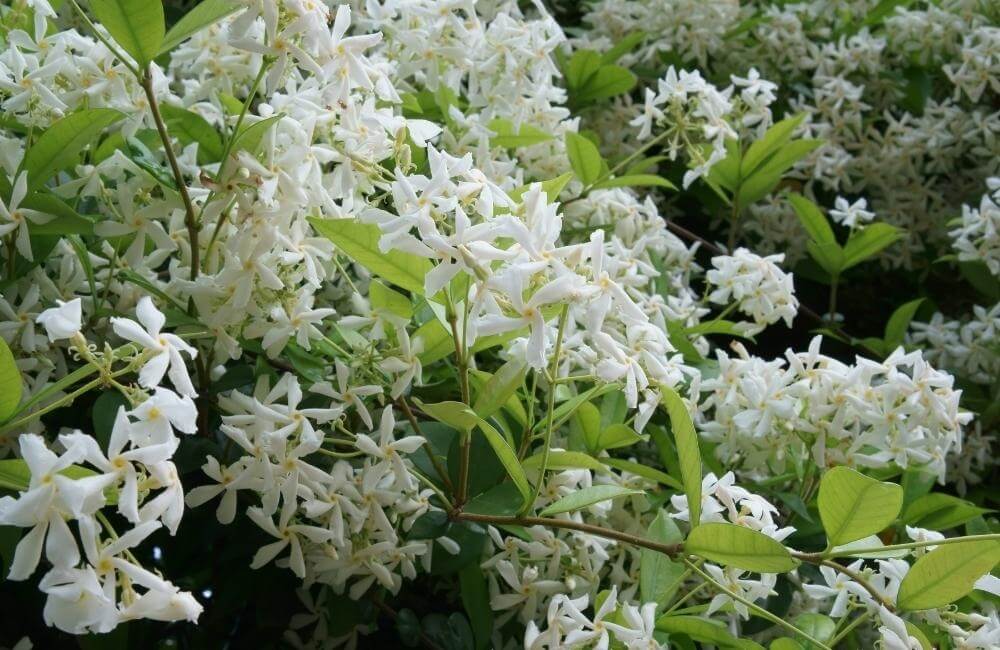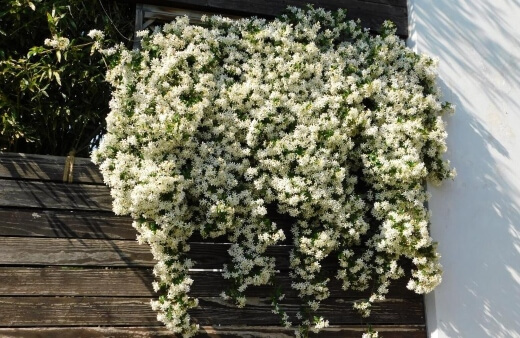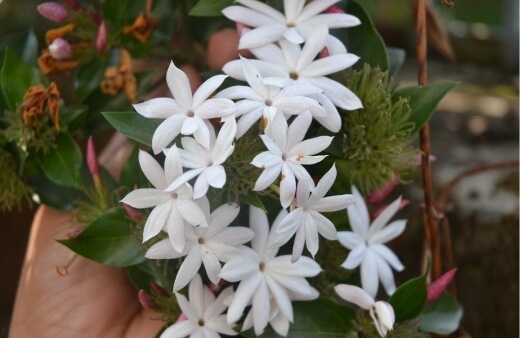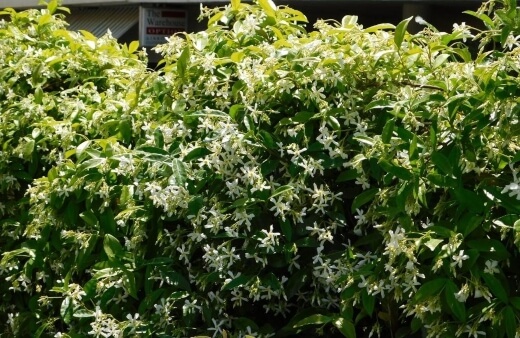Chinese Star Jasmine is a popular evergreen climber with pretty white flowers. In warmer weather, these fragrant blooms fill the air with their delicious, sweet scent. The rambling plant works well as a groundcover, climber along a fence line, or as a screen due to the quick-growing and dense shiny green foliage.
Easy to grow and maintain, Chinese Star Jasmine is a must-have plant for your garden! This guide is packed full of advice on how to grow and care for Star Jasmine.
More...
Botanical name: | Trachelospermum jasminoides |
|---|---|
Botanical family: | Apocynaceae |
Introducing Chinese Star Jasmine

Trachelospermum jasminoides is a species of the Apocynaceae family and is native to Southeast Asia. Trachelospermum jasminoides are commonly known as Star Jasmine, Chinese Star Jasmine, Chinese ivy, Chinese Jasmine, and Southern Jasmine. In America, it is also known as Confederate Jasmine.
The plant has dark green, glossy-textured oval-shaped leaves. In cool conditions, some of the leaves can turn a bronze colour. In warmer weather, Chinese Star Jasmine produces clusters of fragrant white starry flowers, approximately 1-2 cm in size.
The vigorous evergreen climber can grow to a height of between 2-4 m on a structure and can spread up to 3 m wide in the right conditions. As a ground cover, the plant will grow to about half a metre tall.
Suitable for frost-free gardens. Star Jasmine plants are drought tolerant when established.
Star Jasmine Varieties
Although Trachelospermum jasminoides is one of the most popular jasmine cultivars, there are some other great varieties that may offer a different aesthetic appeal you’re looking for. These include:
- Trachelospermum asiaticum. This is a Chinese native jasmine, with equally deep green foliage and small white flowers. This variety isn’t known to be particularly hardy. However, it’s the perfect choice for growing indoors.
- Trachelospermum asiaticum ‘Ogon Nishiki’. This is a variegated cultivar of the above plant. It has an intricate foliage with yellow gold veins on the leaves. It’s an avid climber but can also be grown as a ground cover.
- Trachelospermum jasminoides ‘Variegatum’. This is a variegated variety of star jasmine, with deep green foliage and pale green veins.
Using Star Jasmine in Your Garden
As mentioned, the trailing habit of this plant makes it perfect for any kind of trellis or wall. Here are some styling ideas to help you pick where you want to grow your jasmine.
- Plant your jasmine along the poles of your porch or around a pergola.
- Allow your jasmine to twine up trees for a wonderful effect in both summer and winter.
- Use jasmine to cover up an eyesore such as a damaged wall, old fence or even a shed.
- Allow your jasmine to tumble down walls or balconies for a stunning visual effect.
In certain Asian cultures star jasmine is also used for medicinal uses. When turned into a tonic, it is believed to be incredibly useful for the aged as an anti-bacterial, analgesic and antispasmodic treatment.

Chinese Star Jasmine as a Screen or Climber
Climbers like jasmine are fantastic for screening purposes being very quick growing. They are also ideal plants to grow in narrow spaces of the garden.
Consider building a climbing frame adjacent to a fence or as a divider between sections of your garden. Star Jasmine grows best in a somewhat sheltered position.
Plant star jasmine as you would container-grown trees and shrubs by digging holes about 20-30 cm away from the wall or fence. This ensures that the plant is not in the rain shadow of the wall or fence, and it will get enough rainfall.
Secure to a support or trellis. The plant can then lean into the support towards the wall. You’ll need to train and attach the twining vine from early on to avoid the plant flopping back on itself as it grows.
Star Jasmine as Ground Cover
This quick-growing, versatile plant isn’t just a climber and can be grown successfully as a ground cover in your garden. Plant the Trachelospermum jasminoides plants or cuttings at least 1.5m apart as they grow and will spread quickly.
If left unsupported and with nothing to climb, Chinese Star Jasmine will spread and form a dense, low carpet of deep green foliage in your garden. The pretty ground cover will grow to a height of up to 0.5m. Prune to keep the ground cover tidy and control the spread of the plant. Chinese Star Jasmine can become invasive so monitor carefully if it begins approaching parts of the garden that you’d like to keep free of the vine.
How to Grow Chinese Star Jasmine

The Best Soil for Trachelospermum jasminoides
Chinese Star Jasmine isn’t particularly fussy when it comes to soil and will tolerate most soil types. The plant prefers a well-drained, slightly acidic soil. It won’t tolerate waterlogged soils with poor drainage. They don’t like wet feet!
Where to Position Chinese Star Jasmine in Your Garden
The ideal spot for Chinese star jasmine is in a sheltered, sunny spot of the garden with well-draining soil. Protect the plant from strong, cold winds.
There are few climbers that do well in full shade and Chinese Star Jasmine is no exception. The plant will tolerate partial shade, but this may impact the amount to which the plant flowers.
This quick-growing and versatile plant is commonly used by gardeners in a few different ways. Some plant it as an evergreen twining ground cover. Others use it for screening sections of the garden, covering unsightly features, or along a fence line. It can be shaped into a low hedge or positioned to gracefully tumble over a retaining wall.
Regardless of how you want to use this evergreen plant, Trachelospermum jasminoides will look great in your garden with its dense shiny green foliage and contrasting white flowers.

Can you grow Chinese Star Jasmine in pots?
It is possible to successfully grow Chinese Star Jasmine in pots. Whether you have limited space or simply want to control the spread of the plant, growing Trachelospermum jasminoides in a container pot is a great idea. It also lets you place the plant closer to your home, so you can enjoy the heavenly perfume through a window or door when it flowers.
Star Jasmine is fast growing so choose a pot that is at least twice the size of the plant. This is a perennial, long-term plant, so it is a good idea to plant the Star Jasmine in a large container at least 50 cm deep and wide.
Position the container in a sunny spot of the garden, courtyard, or balcony that is sheltered from strong wind. If you want the plant to climb you will also need to provide some support, so position the pot near a column, wall lattice, or insert a supporting trellis near the side of the container.
The vine will need something to wind around and climb. If planting a larger jasmine in the container, weave the existing vines around the trellis. Use an organic high-quality potting mix to give the plant the best chance of success.
Although Trachelospermum jasminoides is drought tolerant you’ll need to water the plant more regularly when growing in a pot than if it was planted in the garden.
When growing Star Jasmine in a pot, you will also need to feed the plant semi-regularly to ensure it gets the nutrients it needs. An all-purpose balanced fertiliser or liquid plant food is a good option.
Propagating Star Jasmine
The most common method of Star jasmine propagation is by means of stem cutting which is best taken in summer. Although, if kept indoors, cuttings can also be taken during the winter, allowing them to establish before planting in spring.
Here is what you’ll need to do:
- Remove a semi-hardwood stem cutting, cutting just before the node.
- In general, smaller cutting has a better success rate. So, take a cutting around 7 cm in length.
- Prepare a small pot or tray with a propagation mix.
- Stick the cutting straight into the mixture and keep your cutting in a warm and sunny spot that is sheltered from any heavy drafts.
- Regularly mist soil to keep it as moist as possible.
For greater success, cuttings can also be dipped into a rooting hormone. Some growers also recommend placing a plastic dome or bag around your cutting, which will help to retain warmth and moisture.
Trays can also be placed onto a heating mat if being propagated in winter. Cuttings generally take around 3 to 4 months to strike. Once new roots have developed, plants can be repotted into a larger pot or container.
It is recommended to replant cutting into a smaller pot for 3 to 4 weeks before planting into the ground. Follow planting instructions as above.
Cuttings can also be rooted in water. However, this can sometimes take longer. Simply remove a cutting and place it into a glass of water. Keep the glass in a sunny spot, changing out the water regularly.
Caring for Chinese Star Jasmine

Star Jasmine is a fairly low-maintenance and problem-free plant, making it a great choice for your garden. You will need to water Trachelospermum jasminoides regularly until the plant is established.
Star Jasmine can tolerate considerable dryness and it isn’t a water greedy plant. It will only require minimal watering once established. You will need to water the jasmine during extended dry periods but otherwise rainfall will probably be sufficient.
Mulch the soil around the plant to improve soil moisture retention.
In good quality soil, Trachelospermum jasminoides shouldn’t need any fertiliser added to the soil. Having said that, a good dose of organic compost will always be appreciated. If you feel so inclined, you could use some slow-release all-purpose fertiliser instead.
The plant will need pruning to shape and to avoid it becoming a tangled mess. You will also want to prune off any runners getting close to the ground before they root if you want to control the spread of the plant in your garden. If left to its own devices the plant can become quite invasive.
Pruning Trachelospermum jasminoides
Star Jasmine can and should be pruned. It is a very lanky plant and so will need trimming to stop it from becoming messy and untidy.
The best time to prune Star Jasmine is after the plant has flowered. When pruning first concentrate on any dead or damaged wood. Then take out an entire main stem or two all the way to the ground.
If you prune back all the side growths this will produce a tangled mess. Instead, tie any stems you need to extend to the framework and shorten side growths from this main framework to around 5cms. Pruning this way will keep the plant tidy and encourage plenty of new shoots for flowering next summer.
Note that Star Jasmine will exude a white sticky milk-like latex when cut. This isn’t harmful but you should clean your secateurs after pruning.
Chinese Star Jasmine Frequently Asked Questions
How long does it take for Chinese Star Jasmine to grow?
Once established, Trachelospermum jasminoides, is a fast-growing plant and it will soon climb and cover a trellis or unsightly wall.
When does Trachelospermum jasminoides flower?
Chinese Star Jasmine flowers from late spring and then for an extended period over the summer months. In the warmer weather, the plant blossoms into sprays of white-trumpet-shaped flowers, and the air is perfumed with their scent.
The clusters of white flowers are highly fragrant and really pop against the contrasting deep glossy green of the leaves.
Star Jasmine Common Pests & Problems

When grown outdoors, star jasmine seems to be relatively problem-free. The most concerns arise when grown indoors. In particular, dense and heavy soils star jasmine can develop Phytophthora root rot, which is why it’s essential to keep a regular watering routine that avoids waterlogging the roots.
Mealybugs, scale insects and spider mites may also target your star jasmine – particularly when indoors. These can be controlled by removing them with a cotton bud, a strong gust of water, or regularly treated leaves with neem oil.
In certain regions, Japanese beetles can also become a problem. These can be treated relatively easily with neem oil or a pyrethrin-based insecticide.
Do you want to add more jasmine plants in your garden? Start growing handsome foliage of Cape Jasmine with our complete growing guide.

Now You Know How to Grow Chinese Star Jasmine
Trachelospermum jasminoides is a great choice for your garden if you are looking for a climbing feature plant, screen, spectacular ground cover, or fragrant hedge. Not only is it a quick-growing, attractive plant but during the warmer months it produces masses of highly perfumed white flowers that smell amazing.
If you have any questions about how to grow Chinese Star Jasmine in your garden, get in touch.
Published on January 11, 2022 by Maisie Blevins
Last Updated on February 11, 2024





Will 15 yr star jasmine reshoot if it is pruned back to hard wood? My plants are very woody up my south facing side fence with some healthy leaves at top. I’d like to encourage new foliage at lower height.
Hi Judy,
Like most woody climbers, it prefers to be cut back to reasonably young wood, but that’s not to say it can’t be done.
We have (or should I say had…) a huge star jasmine climbing up the main wall of our house until last winter when it either got an infestation, or some sort of fungal problem right through its canopy. We nearly lost the whole thing but instead, we cut it right back to the woody base, and its shot back up this year.
It’s a slow process to get it back to what it was, but there’s so much more flower at the base now. Plus, I can cut back every third or fourth branch each year now, and make sure it stays that way.
So, yes, it can be done, but it might take a while to get the shape back to what it was.
Best regards,
Maisie Blevins